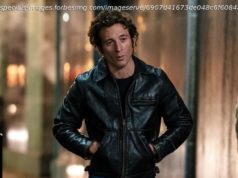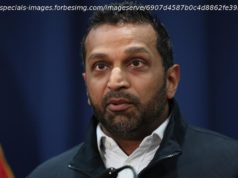Mac Quayle says creating music for Mr. Robot is “like wearing an old pair of shoes that feels good.”
Mr. Robot Season 3 episode 5, “Eps3.4runtime-error.r00,” isn’t considered one of the show’s best episodes purely because of the quality of its cinematography or acting performances, it’s also because of the music. Composer Mac Quayle says there was more music in the episode than any other in the series to date.
“There isn’t music playing all the time, but almost. More than any other episode of Mr. Robot. With the continuous, one-take approach to that particular story we just felt that it needed a lot of music. So it just goes and goes with little breaks and comes back again. And when it’s not playing, yeah, the sound design is so full and rich. Very happy with how that turned out.”
An emergency alarm blares through nearly the entire episode. Mr. Robot is known to draw from ambient sounds, but Quayle calls the way the alarm complemented the score a“happy accident.”
Keep up with this story and more by subscribing now
“Kevin [Buchholz], the sound designer, he may have made some adjustments to it to line it up occasionally with the tempo, and not sure if he did anything to the pitch of it, but it did seem to get along pretty well with the music.”
Most of the background noise — TV static, keyboards typing, radio waves, phones ringing, industrial machinery– is handled by the sound department, though Quayle says there are certain episodes where a collaboration presents a fun challenge. He cites a recent example, in Season 3 episode 4, “Eps3.3metadata.par2, ” when Darlene sits on the train across from the pickpocket. The sounds of the train going over the tracks, what Buchholz calls “click-clacks’ had a rhythm to them. Quayle took the sample, looped it in time and used that as the tempo of the music. “It’s really subliminal, and it doesn’t jump out at you that that’s what’s happening, but if you go back and watch that scene and listen to the rhythm of the music and the train locked together, it’s kind of cool.”
Most shows develop a sound to associate with each character or scene, but Mr. Robot takes a different approach. Often, the show’s music stays intact across multiple shots. The camera can go from Dom, to Elliot, back to Tyrell, and the music stays the same, creating an evocative subtext for viewers.
“Sam [Esmail, the show’s creator] loves letting a continuous musical idea just go across a number of scenes. And I think it’s pretty effective. It keeps this vibe going, often this tension going, that is not a whole lot of big turns in the music. That said, there are some themes that get spread around to different characters.”
For example, in scenes showing Elliot or Mr. Robot alone, the music never seems to have any clear resolution. One song on Vol 4 soundtrack, “2.8 2-Ph4Se. Vox,” has a persisting crescendo with very few satisfying chords.
“It’s just kind of a feeling thing. I don’t recall sitting down and thinking, ‘You know, the music I’m going to write isn’t going to resolve, it’s going to constantly be rising.’ It is just sort of what came out. I suppose I could try to impose some meaning on it after the fact, and say that at this point in the story, nothing is resolved. This whole story arc is just like spiraling somewhere.”
Mr. Robot takes a lot of risks in its plotting and character development, but retains a sense of aesthetic restraint. Sonically speaking, Mr. Robot leaves room for white space as well. That’s actually the initial conversation for every episode — what’s called the “spotting session.”
“We talk about where the music should start and stop and what it should try to convey in each music cue. It’s pretty deliberately plotted out from the beginning. Most often, that map stays intact. Occasionally, we will get down to the final mix and it will be decided that maybe this scene doesn’t need any music, or let’s wait and start the music later in this other scene.”
Sometimes Esmail will get the ball rolling with a soundscape. Other times, Quayle will present an idea after experimenting with various sounds and melodies. It’s an ongoing collaboration with a lot of trial and error, which makes sense in light of the unique musical choices in scenes such as Dom chatting with her partner about lunch over a spaghetti western inspired melody (eps3.5_kill-process.inc). These distinctive compositions can take a scene to another dimension.
“There can be a number of back and forths, depending on that particular scene and how precise the sound is that Sam is hearing in his head that he wants me to find for him,” Quayle elaborated. “Some of it has meaning behind it. We’ve chosen this sound here because of this particular thing that’s happening. But a lot of times, it’s more just about feeling. It just feels right. It gives us the feeling we are looking for in the scene. Maybe theres not on paper some reason why that sound is there.”
Relying on instinct frees Quayle from thinking too much during the creative process. “I’ve been working with synthesizers and electronic music for a very long time. I’m really able to just draw from these decades of experiences. It helps informs a lot of the musical choices that I make. So it feels pretty comfortable, like wearing an old pair of shoes that feels good,” he explained.
The music for Mr. Robot has evolved since Season 1, which was almost exclusively electronic. In Season 2, Quayle expanded into more organic sounds. For Season 3 and beyond, Quayle wants to push the boundaries even further.
„We are going with more organic sounds and expanding some of the tone and different styles of music so it’s been pretty rewarding to push the Mr. Robot sound out and have it go in some other directions. That will continue throughout the end of Season 3.”
Mac Quayle will perform a selection from all three seasons at The Roxy on Dec. 5. Follow this link to learn more about his upcoming performance and catch Mr.
Start
United States
USA — Music Mr. Robot Composer Mac Quayle Takes Fans Inside His Creative Process






